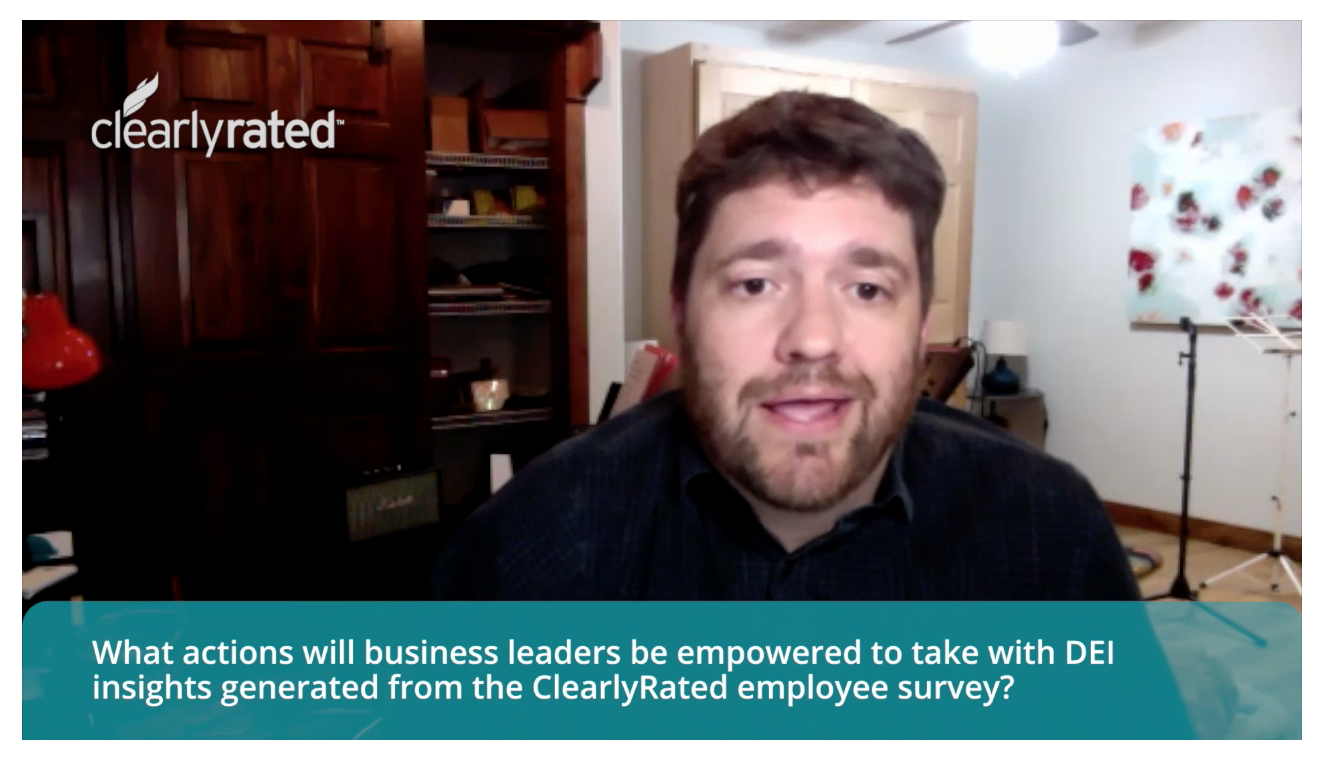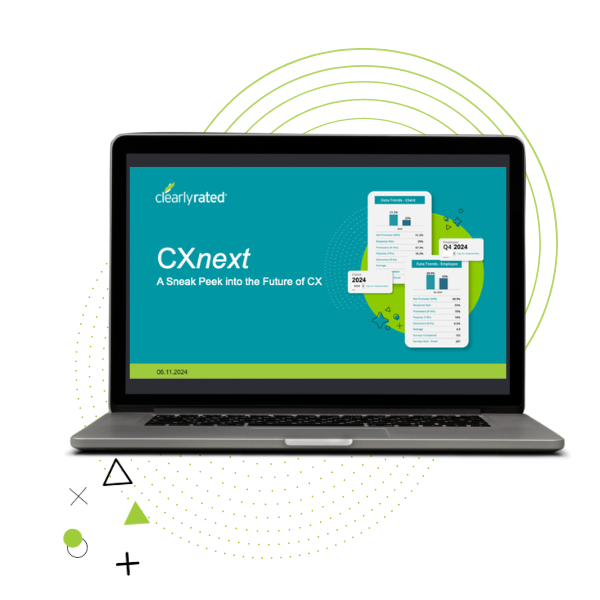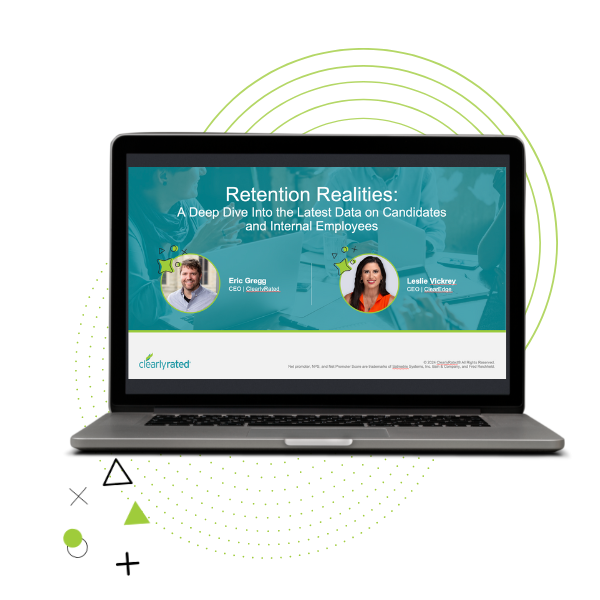With the launch of ClearlyRated’s internal employee satisfaction survey program, we have received some thoughtful and timely questions from our clients and partners about the diversity, equity, and inclusion (DEI) aspect of the program. These questions include:
- Why is now the time for companies to invest in surveying their employees and measuring their DEI efforts?
(0:00 – 1:21 on video; or jump to my transcribed answer) - How did ClearlyRated decide to incorporate diversity, equity, and inclusion (DEI) considerations into the internal employee survey product?
(1:26 – 3:02 on video; or jump to my transcribed answer) - What are the questions in the survey that ask about DEI and how did ClearlyRated select them?
(3:05 – 5:02 on video; or jump to my transcribed answer) - How can business leaders ensure that employees feel comfortable answering survey questions openly and honestly?
(5:05 – 6:53 on video; or jump to my transcribed answer) - What actions will business leaders be empowered to take with DEI insights generated from the ClearlyRated employee survey?
(6:57 – 8:17; or jump to my transcribed answer)
Check out the video above (or the transcribed Q&A below) to get my perspective on this important initiative, and how B2B service firms can leverage the ClearlyRated employee satisfaction survey to measure and improve their DEI outcomes.
Why is now the time for companies to invest in surveying their employees and measuring their DEI efforts?
The key thing to understand here is that for most people in this country and in the world today, they are dealing with additional anxiety around work, around health, around their sense of belonging in a way that they haven’t—we haven’t—societally experienced collectively like this in most of our lifetimes. And so to not take this opportunity to show your employees with actual action that you care about their experience and that you want to be supporting them throughout that, it’s gonna give you a black eye that is going to last, not months, but years in terms of their perception of the leadership of your team. And in addition to that, they need to feel heard and they need to be heard during this time period. There are so many things that you might not understand that you’re doing that is actually creating more anxiety for your employees. And while it might not lead to a talent flight today, it’s going to lead to a talent flight tomorrow. We have to engage our employees and give them the opportunity to bring their best selves to work. And the only way you do that when there’s so much going on outside of their work lives is to help understand how best to support them within their work lives.
How did ClearlyRated decide to incorporate diversity, equity, and inclusion (DEI) considerations into the internal employee survey product?
As much as I would like to say that it was my idea and my brainchild from the start, it wasn’t. It actually came from one of the newer members of our team who really asked an important question which is “Is it enough to just impact within our four figurative walls or is there an opportunity to impact a wider audience? We serve multiple industries that employ many millions of people directly and many more millions of people in a temporary capacity. And so why wouldn’t we utilize our skills of getting experience data and getting—and providing people with a platform to care about something and take action on something they already care about. Why wouldn’t we utilize that to really influence the entire industry.” And it really made a ton of sense and because of that, it was just the logical thing for us to do is—we already knew it’s going to be important to get feedback from employees during this time when there’s so much anxiety, so much change, so much social unrest. And to then be able to give firm leaders an opportunity to really, very simply assess where they are on that path and give them the tools to improve that just made logical sense.
What are the questions in the survey that ask about DEI and how did ClearlyRated select them?
There’s a challenge on this because what you really want to do when you’re designing a survey is that you want to balance effectively the depth of the survey, the number of questions, along with the accessibility of the survey and the ability for people to take that survey amongst all the many things that are going on so you get a really high response rate. And so what we did was we took our existing survey which had some important questions for overall employee experience that we’ve been leveraging for over a decade. And we went and did our homework and pulled three additional DEI focused questions around the sense of belonging, around what leadership’s doing though they’re actions, and around the opportunity for advancement regardless of race, gender, and any other aspect other than performance. And so we started there and those are the questions that are added to that survey. But what’s actually even more important than those questions, and those questions are vitally important, is understanding how on all of the other questions: fairness of compensation, having flexibility in their life, just overall willingness to recommend the firm. How did those questions differ if you’re a white male versus a non-white male, a female, if you’re a member of the LGBTQ+ community? All of those things really matter a lot and we’re uniquely positioned to be able to take those demographics and help firms understand if they’re leaving people behind inadvertently in how they run their business. And so making sure we’re creating a place where people can bring their best selves to work and their full selves to work every single day. The only way you do that is by understanding where those differences lie.
How can business leaders ensure that employees feel comfortable answering survey questions openly and honestly?
The question is how do you make sure your employees feel comfortable and confident in answering the questions openly and honestly on the survey questionnaire like this, especially one that is so personal, right? It’s one thing to answer “What does this company do well? What does this company need to improve?” It’s another thing to put down—you know—to identify in a particular way that potentially makes you feel very vulnerable. And so the key to that really comes to trust and there’s something in your process that can build trust. One of the things that we do is we actually send the survey. It doesn’t look and feel like it’s coming from the CEO of the firm. It actually comes from me. And we coach our teams to speak to that internally and say “look there will be an outside party that is conducting the survey. In addition, you’ll be receiving an email directly from them. We won’t have direct access to that.” And then behind the scenes, it’s not enough to just say “hey we’re not going to target that way.” You have to actually have things put in place to minimize the ability for somebody to drill down deep enough to be able to identify somebody. If you have a leadership team of 10 people and half of them are men and half of them are women, and only two of the men are in the age group 50+, and one of those people identify as LGBTQ+, it’s pretty easy to identify who that person is when you can get down to a sample size of one. So you have to avoid that and you have to have things built into your system that prevent people from even inadvertently doing something like that.
What actions will business leaders be empowered to take with DEI insights generated from the ClearlyRated employee survey?
So there’s a couple things that are gonna be really important. And the most important thing is that you do actually take action on this. We need to recognize that this is an opportunity to fundamentally shift, in a positive way, the industries that we’re a part of. And the only way that that happens is taking action on really strong data. And so, people that participate in the program with us, they’re not only going to be able to see how their entire organization use their progress around diversity, equity, and inclusion, but they’re also going to be able to see—highlight those differences by the demographic groups. And then most importantly, they’re going to be able to get the context of being able to compare that to their peers within the industry to understand where they are on that journey. And what the logical next steps are to be able to take. The biggest thing that we really look at is where is that gap analysis? Where are the perceptions of the experience and the actual experience vary different based on demographic areas that we wouldn’t want them to be different? We understand that somebody that’s new to an organization might have a different perspective than somebody that’s been there for 10 years, but there should never be a case where somebody feels like their opportunities are different because of how they identify.
Do you have other questions about DEI or ClearlyRated’s Employee Satisfaction Survey Program?
I’d be more than happy to continue this discussion with you. Please feel free to send me a message on LinkedIn or to contact the ClearlyRated team if you’d like to learn more about our employee satisfaction survey program.





